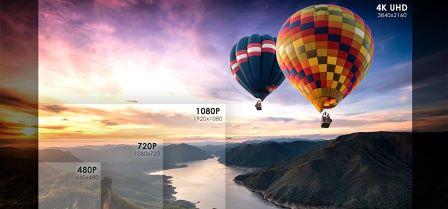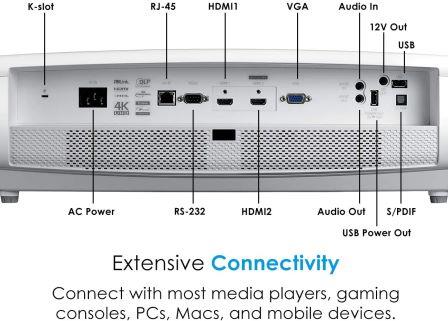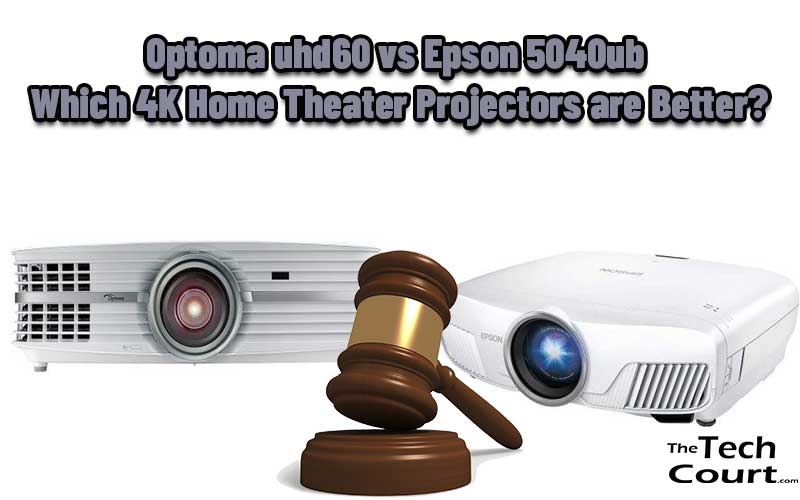Table of Contents
Projectors are used as home theatres, project presentations, and more. A projector is affordable and easy to use. It doesn’t require difficult installation and it delivers the best operation when in use. The projector offers a larger display and will require less room light to display the images. It is portable and durable to use. Some projectors come with unique built-in speakers to deliver quality sound while some do not have a speaker. So, let’s compare the Optoma uhd60 vs Epson 5040ub, and choose which is better.
The Optuma uhd60 comes with 4K Ultra High Definition that offers breath-breaking image quality. It comes with great color contrast and brightness. The Optuma uhd60 comes with an HDMI 2.0 with HDCP 2.2 connectivity that delivers the best content when it is connected to other devices. The Epson 5040ub comes with a 4K enhancement technology that provides 4K content with no rainbow color effect. It also delivers the best color and contrast ratio.
Optoma uhd60 vs Epson 5040ub – Similarities
Design
The Optoma uhd60 and the Epson 5040ub come with a color reproduction of up to 1.07 billion colors. Both devices come with an Aspect ratio of 16:9 widescreen and it is also compatible with 4:3 modes. They are light-weighted, portable, and easy to move around. Both devices come with a contrast ratio of 1,000,000:1.
Other features
The Optoma uhd60 and the Epson 5040ub both come with remote control for easy control. Both projectors have several methods of projecting which are front, ceiling mount, and rear for comfortable viewing. They also come with security features like password protection and Kensington lock.
Side by Side Comparison
| Name | Optoma uhd60 | Epson 5040ub |
| Image |  |  |
| Total weight | 16lbs | 24.3lb |
| Projector output | 4K | HD, 2D, 3D, 1080p, 4K x 2K |
| Color and White brightness | 3000 lumens | 2500 lumens and 2500 lumens |
| Contrast ratio | 1,000,000:1 | 1,000,000:1 |
| Focal length | 20.91 mm – 32.62 mm | 22.5 mm – 46.7 mm |
| Connector | HDMI, VGA input, Audio-In (3.5mm), Audio-Out, USB, USB Mini, RJ-45, and 12V Trigger | HDMI, Mini USB, RJ45, RS-232c, 12V Trigger, and USB |
| Price |
Differences Between Optoma uhd60 vs Epson 5040ub
So, let’s take a look at the differences between Optoma uhd60 and the Epson 5040ub.
Projection

Optoma uhd60:
This projector comes with a single 0.66” TRP S610 4K UHD DMD DLP Technology. It doesn’t have a pixel number. The projector comes with a 4K Technology and UHD (3840 x 2160) maximum resolution. It has a projection distance of 4.2 – 30.5 inches and a projection screen size of 26.45 – 302.2 inches. The Optoma uhd60 has a throw ratio range of 1.39 – 2.22. It comes with a noise level of 25 dB – 28 dB.
Epson 5040ub
The Epson 5040ub has an Epson 3LCD, a 3-chip optical engine, and a pixel number of 2073600 dots. It comes with an enhanced 4K technology and offers projection outputs such as HD, 2D, 3D, 1080p, 4K x 2K. This projector has a projection distance of 50 – 300 inches and a throw ratio range of 1.35 – 2.84. It also comes with an in-built 20 dB – 31 dB.
Read next – Epson 2030 vs 2040: Which Home Theater Projectors are Better?
Lens

Optoma uhd60
The projector comes with an F-number of 2.5 – 3.26 and a focal length of 20.91 mm to 32.62 mm. It has a 1.6x optical (manual) zoom type and
Epson 5040ub
This projector comes with an optical zoom lens with a zoom ratio of 1.0 – 2.1. It comes with an F-number of 2.0 – 3.0. and focal length of 22.5 mm – 46.7 mm. This projector has a vertical lens shift of +/- 96.3 and a horizontal lens shift of +/- 47.1. It has a lens cover such as a powered and slide lens shutter.
Read next – Epson 4010 vs 5040: Which Home Cinema Projectors are Better?
Color

Optoma uhd60
This projector features 3000 lumens of color brightness and 3000 lumens of white brightness.
Epson 5040
The Epson 5040 comes with a color brightness of 2500 lumens and white brightness of 2500 lumens. It has a full 10-bit color processing and up to 1.07 billion color reproduction.
Dimension

Optoma uhd60
The Optoma uhd60 comes with a weight of 16lbs and a dimension of (19.6 (W) x 13 (D) x 5.6 (H)) inches.
Epson 5040
The Epson 5040 weighs 24.3lb and comes with an including feet dimension of (20.5 (W) x 17.7 (D) x 7.6 (H)) inches and an excluding feet dimension of (20.5 (W) x 17.7 (D) x 6.7 (H)) inches.
Lamp
Optoma uhd60
It comes with a 240 W lamp and it has a lamp lifespan of 4,000 hours for bright mode, 10,000 hours for ECO mode, and 15,000 hours for dynamic mode.
Epson 5040ub
The Epson 5040ub comes with a lamp type of 250 W UHE and up to 5,000 hours (Eco mode), up to 4,000 hours (Medium Mode), up to 3,500 hours (High mode).
Connection
Optoma uhd60
This projector comes with a connection such as HDMI, VGA input, Audio-In (3.5mm), Audio-Out, USB, USB Mini, RJ-45, and 12V Trigger.
Epson 5040ub
The Epson 5040ub comes with a connection such as HDMI, Mini USB, RJ45, RS-232c, 12V Trigger, and USB.

Speaker
Optoma udh60
This projector has two 4W speakers for delivering optimal sound when needed.
Epson 5040ub
The Epson 5040ub doesn’t an in-built speaker.
Warranty
Optoma uhd60
It comes with a 1-year warranty.
Epson 5040ub
It comes with a 2-year warranty.
Pros and Cons
Before our final verdict, we will go over a few pros and cons of the Optoma uhd60 and the Epson 5040ub.
Optoma uhd60
Pros
- The projector delivers great color and accuracy.
- It comes with a native 4K UltraHD resolution.
- It is bright enough to use in almost any lighting condition.
Cons
- The projector’s speaker isn’t loud enough.
Epson 5040ub
Pros
- It comes with great picture quality.
- It offers rich colors with no rainbow effect.
- It offers excellent performance when in use.
Cons
- The projector can have power failure issues.
The Final Verdict
After considering their features, we decided to choose the Epson 5040ub. This projector comes with good brightness, high-quality picture, and it’s easy to use. It offers HD, 2D, 3D, 1080p, 4K x 2K viewing for comfortable streaming. It has a good lens position and color resolution. It comes with an automatic open and close lid shutter that activates when in need. This automatic open and close lid also protects the lens from scratches and dust.
